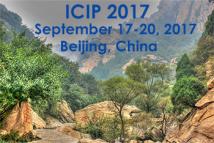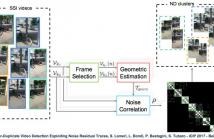
The International Conference on Image Processing (ICIP), sponsored by the IEEE Signal Processing Society, is the premier forum for the presentation of technological advances and research results in the fields of theoretical, experimental, and applied image and video processing. ICIP has been held annually since 1994, brings together leading engineers and scientists in image and video processing from around the world. Visit website.
- Read more about LEVEL-SET FORMULATION BASED ON OTSU METHOD WITH MORPHOLOGICAL REGULARIZATION
- Log in to post comments
Noisy image segmentation is one of the most important and challenging problem in computer vision. In this paper, we propose a level set segmentation technique inspired by the classic Otsu thresholding method. The front propagation of the proposed level set based method embeds a cost function that takes into account first-order statistical moments. In order to deal with highly noisy images, we also added a morphological step to our algorithm which led the final segmentation more robust and efficient.
- Categories:
 22 Views
22 Views
- Read more about NEAR-DUPLICATE VIDEO DETECTION EXPLOITING NOISE RESIDUAL TRACES
- Log in to post comments
Video phylogeny research about joint analysis of correlated video sequences has shown the possibility of developing interesting forensic applications. As an example, it is possible to study the provenance of near-duplicate (ND) video sequences, i.e., videos generated from the same original one through content preserving transformations. To perform this kind of analysis, accurate detection of ND videos is paramount. In this paper, we propose an algorithm for ND video detection and clustering in a challenging setup.
- Categories:
 17 Views
17 Views- Read more about Action Recognition In RGB-D Egocentric Videos
- Log in to post comments
In this paper, we investigate the problem of action recognition in RGB-D egocentric videos. These self-generated and embodied videos provide richer semantic cues than the conventional videos captured from the third-person view for action recognition. Moreover, they contain both appearance information and 3D structure of the scenes from the RGB modality and depth modality respectively. Motivated by these advantages,
- Categories:
 7 Views
7 Views- Read more about ICIP_1343
- Log in to post comments
One of the most critical missions of sonar is to capture deep-sea pictures to depict sea floor and various objects, and provide an immense understanding of biology and geology in deep sea. Due to the poor condition of underwater acoustic channel, the captured sonar images very possibly suffer from several typical types of distortions before finally reaching to users. Unfortunately, very limited efforts have been devoted to collecting meaningful sonar image databases and benchmark reliable objective quality predictors.
- Categories:
 15 Views
15 Views- Read more about CIRCLET BASED FRAMEWORK FOR OPTIC DISK DETECTION
- Log in to post comments
Optic Disc (OD) detection in retinal fundus images is a crucial stage for the automation of a screening system in diabetic ophthalmology. Most researches for automatic localization of OD benefit the regions of vessels. In this paper, we present a fast and novel method based on the Circlet Trans-form to detect OD in digital retinal fundus images that doesn’t utilize the location of the vessels. First, each R, G and B band is enhanced using CLAHE method. Then, the enhanced image in RGB color space is converted to L*a*b one.
- Categories:
 8 Views
8 Views
- Read more about CONTRAST-ACCUMULATED HISTOGRAM EQUALIZATION FOR IMAGE ENHANCEMENT
- Log in to post comments
Among image enhancement methods, histogram equalization (HE) has received the most attention because of its intuitive implementation quality, high efficiency, and the monotonicity of its intensity mapping function. However, HE is indiscriminate and overemphasizes the contrast around intensities with large pixel populations but little visual importance. To address this issue, we propose an HE-based method that adaptively controls the contrast gain according to the potential visual importance of intensities and pixels.
- Categories:
 25 Views
25 Views- Read more about SQUARE TO HEXAGONAL LATTICE CONVERSION IN THE FREQUENCY DOMAIN
- Log in to post comments
Currently, hexagonal image processing is mainly based on simulated data generated by square lattice conversions. For the evaluation of the conversion quality, this paper presents a method for ideal square to hexagonal lattice conversion. Based on the square lattice discrete-time Fourier transform (DTFT), the method first determines the values of the hexagonal discrete Fourier transform (HDFT), and performs the inverse HDFT to obtain the ideal conversion. This method provides a benchmark for evaluating other practical conversions and such evaluation is presented in this paper.
icip-2614.pdf
- Categories:
 31 Views
31 Views- Read more about ALIGNMENT OF OPTIC NERVE HEAD OPTICAL COHERENCE TOMOGRAPHY B-SCANS IN RIGHT AND LEFT EYES
- Log in to post comments
Symmetry analysis of right and left eyes can be a useful tool for early detection of eye diseases. In this study, we want to compare the Optical Coherent Tomography (OCT) images captured from optic nerve head (ONH) of right and left eyes. To do this, it is necessary to align the OCT data and com-pare equivalent B-scans in right and left eyes.
icip_7.pdf
- Categories:
 19 Views
19 Views